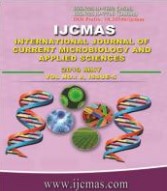


 National Academy of Agricultural Sciences (NAAS)
National Academy of Agricultural Sciences (NAAS)

|
PRINT ISSN : 2319-7692
Online ISSN : 2319-7706 Issues : 12 per year Publisher : Excellent Publishers Email : editorijcmas@gmail.com / submit@ijcmas.com Editor-in-chief: Dr.M.Prakash Index Copernicus ICV 2018: 95.39 NAAS RATING 2020: 5.38 |
A field experiment of rice crop was conducted during Kharif season 2016 at Agro-meteorological Research Farm of N.D.U.A&T, of Kumarganj, Faizabad. The experiment was conducted in Randomized Block Design. The treatment comprised of three dates of Transplanting viz. 5th July (D1); 15th July (D2) and 25th July (D3) with three varieties viz. NDR-80 (V1); Pant Dhan-4 (V2) and Swarna (V3). In this study, DSSAT-CERES model was used to assess the impact of temperature on productivity of crop. Possible changes in temperature and solar radiation are expected to significantly impact the crop growth and yields. In this study, CERES rice model was used to assess the impact of temperature and solar radiation on physiology and productivity of rice crop at Faizabad region, Uttar Pradesh. The simulation of anthesis days, maturity days, grain yield and straw yield were carried out for the range of temperature (maximum and minimum both) -0.5°C and +1.5°C with an interval of 0.5°C temperature from normal, alone or in combination with solar radiation ±0.5, ±1 and ±1.5MJ m-2 day-1 while keeping the other climate variables constant. Anthesis days and maturity days reduced with increasing temperature. At increase of 1.5°C temperature, anthesis and maturity occurred 10 days and 11 days earlier from normal, respectively. Grain yield decreased and straw yield increased concurrently with an increase in temperature by 1.5°C and an increase in solar radiation (up to 1.5MJ m-2 day-1) in comparison with the normal conditions. It is inferred that increasing temperature and decreasing solar radiation hampers the crop phenology and the productivity in Faizabad region.
 |
 |
 |
 |
 |